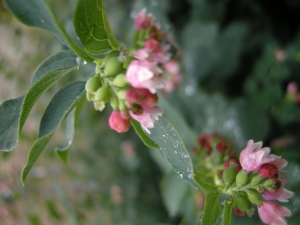Position: Full sun to full shade
Soil: Moist well drained soil
Flowering period: Summer
Eventual Height: 2m
Eventual Spread: 2m
Hardiness: 3a, 3b, 4a, 4b, 5a, 5b, 6a, 6b, 7,a 7b, 8a, 8b, 9a
Family: Caprifoliaceae
Symphoricarpos albus is a deciduous shrub with a dense habit that is part upright, part arching. Its foliage is dark green and rounded, arranged oppositely on the sometimes arching stems. In summer it bears racemes composed of pink, bell shaped flowers, which are followed by large, marble like, globose white fruits.
Symphoricarpos albus, commonly known as Snowberry is native to the Western United States of America but has been naturalised in many temperate climates including parts of England. The entire plant is toxic, containing many dangerous compounds including viburnin, chelidonine, saponins, tannins, terpenes, tryglycerides and coumarins. As some of these compounds induce an emetic effect it is rarely known to cause damage, the harmful chemicals being expelled during violent vomiting.
The etymological root of the binomial name Symphoricarpos is derived from the Greek symploke meaning ‘interweaving’, ‘interlacing’ or ‘connection’ and karpos also Greek meaning ‘fruit’ referring to its fruits appearing in clusters. Albus is derived from the Latin meaning white also in reference to its fruit.
Symphoricarpos albus may be useful to the landscape architect in erosion control, especially in a riparian setting. It may also be used as an informal, low hedge. Care should be taken when locating this plant due to its potentially toxic compounds
Symphoricarpos albus will tolerate almost any soil conditions; it will be happy in neutral, acid or alkaline pH levels, in loam, clay or sand based soils facing any sheltered aspect. It will also tolerate salty coastal soils and urban pollution.
Ecologically, Symphoricarpos albus will attract pollinating insects such as butterflies and honey bees and although it is not native to this continent it has been known to attract large numbers of these pollinating insects and despite its toxicity its fruit is also very attractive to wildlife.
Symphoricarpos albus requires little to no maintenance. Dead or damaged material may be removed in spring, if pruned to be a hedge this trimming may be carried out in summer.






Wonderful plant, I remember having it in a woodland setting in the UK, not just low maintainance but zero maintenance. The only problem could be that it spreads by suckering making it perfect for the control of erosion but this could be aproblem if you plant it in the wrong place. Give it plenty of room to spread, excellent for dry banks or any place where erosion is a problem…
Thanks for the additional information Catherine.